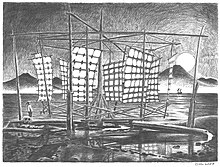Chinese windmill
The Chinese windmill runs like a carousel with a vertical rotor axis at ground level in a circle. Junk sails arranged in a star shape around the axis of rotation , which align themselves with the flow, drive them. This historic windmill works with a technology that is only known from China. Mainly used for the irrigation of fields, it was also used for salt production.
history
China has a long history of windmill use. For a long time, the water supply to the coastal areas in southeast China was powered by wind power.
In the Han tomb uncovered in Liaoyang ( Liaoning Province ), murals were found that suggest the use of windmills in China since the Eastern Han Dynasty (25–220 AD), that is to say for 1700 years.
In the German specialist literature on wind energy , different information has been given about the age of Chinese windmills. Gasch et al. state in the book "Wind Turbines" that Chinese windmills or wind turbines have been known since around 1000 AD. Felix von König, on the other hand, assumes an estimated age of 1500 years in his wind energy dictionary.
Since the Ming Dynasty (1368–1644), the Chinese used windmills to pump water into fields or in salt pans - for salt production - and also for the production of industrial and agricultural by-products.
As far as is known, the first mention of a windmill in Chinese literature comes from Yelu Chucai , who wrote about it in the report of his trip to Turkestan (1219 AD); this could, however, be more a description of a Persian windmill that he found there.
Although the Persian windmill also works with a vertical axis of rotation, the drive surfaces there are rigidly and immovably connected to the axis of rotation and cannot line up with the flow. Therefore, in contrast to the free-standing Chinese windmill, a half-open tower is used with the Persian windmill, so that only the half of the rotor that moves with the wind and not the opposite half of the rotor is brushed by the wind.
In 1959, there were more than 200,000 windmills in operation in Jiangsu Province.
technology
The Chinese windmill, even if it does not have modern aerodynamic wing profiles, is - based on the historical European windmill - predominantly a buoyancy device . Since your sails can easily be rigged and tied up in such a way that they automatically line up with the wind direction, they can run largely unmanned during a period of use. The sails automatically perform two sailing maneuvers in a full turning circle, jibing and cruising , during this maneuver, however, the position of the sails is also in positions in which the propulsion and not the lift determine the main component of the mode of action (see also folding wing rotor ). The typical junk sails found at the Chinese windmill are similar to the lug sails known in Europe . Lugger sails also have the user-friendly property of being able to align themselves automatically with the current.
The irrigation of the rice fields was done with a chain pump , which in this special form is only known from China. This chain pump was also used for the production of salt in saltwater salines. The gradient of the system, with square panes on a wooden chain hinge, transported water up through an open wooden channel was not very steep, about 20 ° gradient, so only small differences in altitude were overcome. The drive mechanism between the rotor and the chain pump consisted of an extensive wooden ring of gears just below the lower booms that led to the sails. From there, an equally wooden spur gear gave a long shaft the angular momentum in order to operate the chain pump with a drive gear on the shaft section positioned outside the windmill construction. This is where the Chinese chain pump (pallet chain pump) differs from the chain pump known as "disk art" in earlier mines in Europe, which also pulled disks directly up through a vertical, all-round closed pipe and thus transported water with it. In order to achieve a higher delivery head, several wind turbines and chain pumps working one after the other were necessary due to the low incline of the Chinese chain pump.
Applications
In addition to being used to irrigate agricultural areas, seawater was also lifted into the salt pans in coastal areas for salt production.
literature
- Hong-Sen Yan, Marco Ceccarelli: International Symposium on History of Machines and Mechanisms. Proceedings of HMM 2008 . Springer, Dordrecht 2009, ISBN 978-1-4020-9484-2 , pp. 295-324 .
- Felix von König: The practical wind energy lexicon: 1700 keywords . Müller, Karlsruhe 1982, ISBN 3-7880-7191-5 , p. 4 .
- Joseph Needham: Science and Civilization in China. Vol. 4 ,. Part 2, Cambridge etc. 1965, p. 560.
Individual evidence
- ^ A b c Hong-Sen Yan, Marco Ceccarelli: International Symposium on History of Machines and Mechanisms. Proceedings of HMM 2008 . Springer, Dordrecht 2009, ISBN 978-1-4020-9484-2 , pp. 295-324 .
- ↑ Xianyang Museum (Xianyang bowuguan)
- ↑ Robert Gasch , Jochen Twele (Ed.): Wind power plants: Fundamentals, design, planning and operation Teubner Verlag, p. 17.
- ↑ Felix von König: The practical wind energy lexicon: 1700 keywords . Müller, Karlsruhe 1982, ISBN 3-7880-7191-5 , p. 4 .
- ↑ Needham: Vol. 4, Part 2, p. 560.
